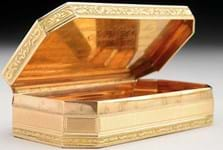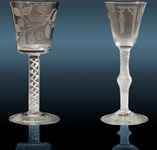
And that is what happened on November 15 when, as part of a 324-lot sale of Glass and English Ceramics, Bonhams Knightsbridge (25/20/12.5% buyer’s premium) offered the 66-lot collection of the Washington lawyer Julius (Jay) Kaplan and his wife Ann.
The Kaplans started collecting glass around 40 years ago. They bought occasionally at auction but chiefly through specialist dealers, notably John Smith of Asprey’s and Mallett, and Christopher Sheppard.
The Kaplans’ ensemble included Venetian and Dutch engraved glasses and candlesticks, but they had a penchant for two collectable categories that epitomise the lighter rococo style of the 1760s: Beilby-decorated and colour-twist glasses.
While values of middle-of-the-road 18th century drinking glasses have been bumping along the bottom, improving little on prices of a couple of decades ago, Beilbys and colour twists are in a different league altogether.
“The colour-twists have always been the holy grail of glass collectors,” says John Smith. Similarly, Newcastle enamelled vessels embellished with pastoral and armorial motifs have been growing in fame and fortune since James Rush published his ground-breaking work The Ingenious Beilbys in 1973.
Both classes are rare – but not so rare that they are unobtainable. Bonhams have sold several Beilby collections in the past decade (see box below).
The Kaplans had no fewer than 17 Beilby and 23 colour-twist glasses, a bumper haul which was one of the major draws of this collection.
Kaplan collection hammer highlights (picture top, captions from left to right)
- 1. The most expensive of the Kaplans’ colour-twist glasses was this 6in (15cm) high engraved example with yellow, white and blue threads to the stem. It made £18,000.
- 2 & 3. Two more of the top-selling colour-twists from the collection. The 7in (19cm) high goblet with a yellow, white and ruby-encircled stem (2) doubled estimate to sell for £15,000. The small 6in (15cm) high wine glass with a canary-yellow thread to the stem (3) made the same price against a £10,000-15,000 guide. In 1997 at Sotheby’s it had sold for £13,000: a record for a canary-yellow mixed-twist glass at the time.
- 4. The most expensive of the Beilby drinking glasses was this 6in (15cm) high opaque-twist-stem wine glass enamelled with a shepherd in a landscape. It sold for £16,000.
- 5. Although it had a cracked and repaired bowl, this Beilby polychrome enamelled glass with the arms of Anderson impaling Consett fetched £8500.
- 6. This rare 7½in (19cm) Beilby workshop armorial glass was not part of the Kaplan collection but featured in the mixed-owner section, in perfect condition. Its polychrome bowl is enamelled with the arms and motto of Kitson of Hengrave Hall, Suffolk. It realised £12,500 against a £7000-9000 estimate.
- 7. This fine example of the Dutch stipple engraving by the master engraver David Wolff decorated with an allegory of the city of Amsterdam realised £30,000 at Bonhams’ sale of the Kaplan collection.
Quality and rarity
As Bonhams’ John Sandon said in the catalogue introduction: “In forming their collection, Jay Kaplan and his wife Ann deliberately set the bar high in terms of quality and rarity. Each purchase had to be one of the best of its kind.”
And Smith expanded on this, observing of his client: “One of his main strengths was that he didn’t just collect 18th century drinking glasses, which some collectors do. He collected English glass and Dutch engraved and enamelled glass, candlesticks and what he referred to as his ‘dry martini’, Venetian shaped, glasses.”
Smith recalls drinking claret out of colour twists with enthusiasts at Kaplan dinner parties. “He wanted glass that looked attractive in the showcase. If it was rare, so much the better,” he added.
Bonhams applied reasonable estimates. Simon Cottle of Bonhams, a Beilby expert who was on the rostrum, confirmed the saleroom’s judicious approach.
He said: “There is a recognition that the prices have had to be readjusted over the last 10 years or so. It’s a market that has been changing like the ceramics market and the silver market – in fact the decorative arts in general.”
All this goes some way to explaining why Bonhams had such a strong result and a total that, with premium, doubled expectations at just over £500,000.
Consigned from outside Europe, there was an extra 5% commission payable on the hammer price of the Kaplan lots.
The presence of one very deep-pocketed online bidder, determined to secure as much of the Kaplan cache as possible, gave this sale a competitive edge. Bidding under paddle 5108, they bested the competition time and again, securing close to a third of the collection.
It transpired after the sale that this major player was the Halim Time and Glass Museum, based in Evanston, Illinois. The museum, which focuses on clocks and Tiffany, has opened a new centre where it will be displaying its newly acquired Kaplan treasures.
Interestingly, the museum did not attempt to buy items in the mixed-owner material that followed. Simon Cottle had a theory on this.
“I think their buying habits in the past have been such that they have been focusing on collections… If they feel that the collector has been buying judiciously then they feel that’s a sort of legitimacy to their own buying.”
A lone buyer cannot set prices, of course. It needs two to create a bidding battle.
The Halim received plenty of competition from other online bidders, the phones and one or two determined players in the room. International interest came from Europe including, said Cottle, “countries not necessarily associated with collecting English glass”.
Kaplan top-seller
Leading the day at an almost double-estimate £32,000 was a rare glass that combined a coloured, cobalt blue-tinted bowl and foot with a multi-spiral opaque-twist stem.
It was once part of the Michael Parkington collection and last sold at Christie’s in 1994 for £10,000 before entering the Kaplan collection.
Only two other examples of this combination are known: one in the Fitzwilliam, the other now in the Durrington collection, sold at Sotheby’s in 2002 for £27,000.
Given that 2002 result, Bonhams’ £15,000-20,000 estimate this time round was not too bullish. The main competition was between the room and the Halim, which emerged victorious at £32,000. The same duo battled over a similar configured glass with an emerald tinted bowl and foot.
Half a dozen of these are known, including two in the Durrington and one sold by Bonhams in 2011 for £11,000. This example, acquired from Asprey’s in 1991, was secured by the Halim at a double-estimate £18,000.
Tale with a twist
The room-based underbidder had more success a few lots later with the most expensive of the colour-twists proper.
They paid out £18,000 for an exceptional 6in (15cm) engraved wine glass with yellow, white and blue threads to the stem, and £15,000 for a 7½in (19cm) bucket-bowled example with a stem of white, yellow and red threads. Both Asprey’s purchases from the mid- 1980s, they more than doubled the estimates.
The Kaplans’ Beilby glasses covered a range of styles and forms from drinking glasses to decanters, in white and coloured enamels with pastoral and armorial motifs.
Most expensive at £16,000 apiece were a masonic firing tumbler, polychrome enamelled with the Freemasons’ arms, and a 6in (15cm) opaque-twist-stemmed wine glass painted in white with a delicate landscape of a young shepherd playing a recorder with his sheep and dog. The first went to a phone bidder, the second to the Halim.
Demand was sustained for two damaged Beilby armorial goblets. Both of these had broken and repaired bowls, but the polychrome enamelling was a textbook example of the family’s decorating skills.
The Kaplans had bought the goblet with the polychrome arms for Anderson impaling Consett at Christie’s, and Smith recalls how he encouraged Jay Kaplan to overlook the damage, as it would be cheaper than a perfect example, and “just go and buy it for a lot less because it is so good”.
The second glass, with arms for Prince Wilhelm V of Orange Nassau with Princess Frederika Sophia Wilhelmina of Prussia, was purchased from Asprey’s in 1989.
Guided at £7000-9000 and £5000-7000 respectively at Bonhams, both sold to the Halim at £8500 and £4500.
Going Dutch
Dutch stipple-engraved glasses represent the tour de force of the engraver’s art in terms of skill and delicacy. These were later acquisitions for the Kaplans, who had five examples to sell.
The most expensive was a superb facet-stemmed example engraved by the master craftsman David Wolff with an allegorical scene representing Amsterdam and the celebration of free trade and commerce.
Purchased from the well-known Dutch dealer Friedes Lameris, this 7in (18cm) high glass was yet another purchase for the Halim at £30,000.
Past Beilby auctions
Previous single-owner collections sold at Bonhams that featured a large selection of Beilby glass include:
- The Chris Crabtree collection, sold December 16, 2009.
- The AC Hubbard collection, sold November 30, 2011.
- The Hubbard sale also established the current auction high for a Beilby glass: the Prince William V Royal armorial goblet which realised £90,000 as an after-sale.















